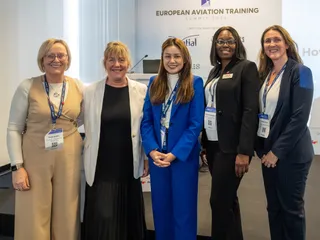Aviation Lessons from the COVID-19 Pandemic
Contact Our Team
For more information about how Halldale can add value to your marketing and promotional campaigns or to discuss event exhibitor and sponsorship opportunities, contact our team to find out more
The Americas -
holly.foster@halldale.com
Rest of World -
jeremy@halldale.com

Preamble
Air Transport Safety Concerns
Recent high-profile aviation accidents may have prompted major media outlets to question the safety of flying post pandemic. A notable example was a CNN report in March 2025, which, like many others, failed to address the probable lack of global preparedness for likely threats during the eventual recovery from the pandemic.
Poor Preparation
While those in leadership roles were understandably focused on managing the immediate impacts of the pandemic, they seemed unable to foresee and mitigate the inevitable challenges that would arise during recovery. It was evident as early as 2020 that airlines would strive to recover their severely damaged businesses quickly, while simultaneously addressing a surge in pent-up public demand for air travel. This combination of factors posed significant safety risks, particularly if staffing pipelines were disrupted. Without robust regulatory strategies to prepare the industry for rapid growth, public confidence in aviation safety could be compromised.
Talent Drain
This commentary examines the anticipated staff shortages that emerged as the industry began to recover from the pandemic, highlighting how proactive measures could have been taken during the downtime to address the needs of safety-critical professionals such as pilots, maintenance technicians, cabin crew members and air traffic controllers. While airlines received financial support, training organizations did not, leading many to close their doors.
One of the most surprising aspects of 2020 was the apparent failure of governments and regulators to recognize the inevitability of these threats. A modest amount of research and basic arithmetic would have revealed that the pandemic would choke the supply chain of critical professionals.
As an author who published multiple warnings from 2020 to 2023 in the aviation press, this commentary is presented to draw lessons from the pandemic and advocate for improved crisis management processes for future disruptive events.
An Insider’s Commentary
A confluence of government and regulatory agency, financial and workforce forces are worth recalling.
As the Pandemic Closed Borders
In March 2020, the COVID-19 pandemic triggered widespread border closures and the grounding of airliners worldwide, raising urgent concerns about the industry's survival. Airlines typically operate on thin margins, and each grounded aircraft—valued between USD 40 million and 400 million—rapidly depleted financial reserves. The financial impact on many operators was extreme and unprecedented.
For airlines lacking domestic networks or alternative income sources like cargo, prolonged grounding was completely unsustainable. Recognizing airlines as essential infrastructure, governments intervened with financial support to help sustain these businesses amid dramatic reductions in passengers and revenue. Despite this, at least 60 airlines ultimately closed.
While the immediate threats posed by the pandemic were clear to many within the industry—especially those focused on crew training and safety—proactive strategies and guidance from oversight bodies were conspicuously absent. Governments and regulators concentrated on immediate impacts, lacking a playbook for such an unprecedented situation, and few anticipated the long-term effects on airline supply chains that could hinder recovery. One severely impacted sector was flight training schools, which provide critical professionals for the industry. Lacking the financial bailouts received by airlines, many of these schools faced devastating revenue losses without students, resulting in approximately 30% closing worldwide—a predictable outcome for anyone with a grasp of basic arithmetic.
A Hopeful Assumption?
As airlines grounded flights, around 50% of the 250,000 airline pilots were left without work, either temporarily or permanently. Many airlines seemed to assume that their pilots and other key professionals would return to service in bulk when needed. However, there is a significant cost for pilots to maintain licence currency, and they had suddenly lost their income. What could have been foreseen, and happened, was that the uncertainty surrounding the pandemic's duration led many senior pilots to retire from the profession early or seek alternative employment. Others who were younger had to find other work to feed their growing families; and left the profession. It is estimated that only approximately 60% of grounded pilots returned immediately to airline service.
Experience
Pre-pandemic, the airline industry was already experiencing a decline in average experience levels on flight decks, a situation exacerbated by a scheduled surge in retirements. The pandemic worsened this trend, raising safety concerns among industry professionals.
Challenges in Pandemic Recovery
The recovery period presented 11 compounding challenges:
- The urgent drive for airlines to regain commercial viability created a temptation to cut corners in staffing;
- Larger, better-resourced airlines poached qualified pilots from their competitors, leading to additional airline failures beyond those directly caused by the pandemic;
- Airlines, in their search for pilots, recruited experienced flight instructors from flight schools, severely disabling they ability to maintain standards;
- The reduced number of primary flight schools placed significant resource stress on the remaining institutions as student enrolment surged. Financial pressures led to a focus on student churn rather than the quality and relevance of training;
- In safety-critical professions, the quality of initial training is crucial for future performance and safety. Surviving but damaged flight schools will struggle for many years to rebuild to pre-pandemic capacity and enhance their training product to contemporary airline needs;
- 'Learnt first lasts longest.’ Sub-optimal initial training for professional pilots, even when training is conducted to minimum regulatory standards, can sow latent pathogens into airline operations downstream, lying in wait for a set of circumstances where the ‘holes in the Swiss cheese’ all line up (attributed to the late Professor James Reason);
- Despite the clear opportunity to establish new flight schools during the pandemic—arguably the best long-term business opportunity in this sector for decades—few investors were willing to invest in aviation enterprises;
- The demand for pilots surged from a depleted pool, causing significant backlogs for training aircraft manufacturers, with delivery times extending to two years or more;
- Returning pilots found themselves working significantly more hours than pre-pandemic, often approaching legal limits, raising concerns about increasing sickness rates and mental health issues;
- The overall experience levels on flight decks post-pandemic were further diminished compared to pre-pandemic levels, leading to rapid promotions that placed less experienced individuals in command positions; and
- The safety repercussions of the lack of proactive regulatory action during the pandemic may be felt for years to come.
Applying Lessons Learned
To improve future governance, three critical questions must be asked:
- What were aviation regulators worldwide doing during this crisis? In 2020, they appeared oblivious to the industry's obvious safety threats in the return to normal pre-pandemic operations;
- How could such clear warning signs be overlooked, despite numerous industry insiders raising alarms; and
- Why were the foreseeable staffing shortages a surprise?
By addressing these questions and applying the lessons learned, we can better prepare for future challenges in this remarkable industry.
Post-script
After sharing this article with another very experienced and active professional pilot, his simplified commentary follows:
“But the industry is not providing or even suggesting solutions. When those at the top, the regulators, start addressing it and changing the rules to allow cost effective and relevant training without compromising standards, then progress can’t be made. To help with the training standards and experience in flight schools, for example, airline pilots could be utilized. But the present regulations treat experienced pilots as if they a new 200-hour commercial pilot and make them jump through the full hoops of instructor training without factoring in any operational experience. This takes years. So, nobody will go through the long-drawn-out pain of doing this. An abbreviated competency-based instructor course would be a great advantage. But the regulations need to be amended for this. The elephant in the room is never addressed adequately. Where is the money to fund FTOs coming from?”
Editor’s Note:
John Bent, FRAeS remains an active contributor to CAT’s editorial and live events programs. The author’s previous articles for CAT include:
Opportunity in Crisis: The Flight Academy of the Future
22 Challenges to Airline Pilot Supply ... and a Call to Urgent Action
Airline Pilot Training: Time to Revisit the Basics?
The Pilot Training Opportunity is Dramatic Right Now
Biography
Capt. John Bent has been flying and training pilots in an aviation career launched in 1961 in the RAF. His numerous civil aviation career highlights include positions of increasing responsibility at five airlines and other organizations. Bent has accumulated 13,000 hours across 28 types. Capt. Bent’s achievements at Cathay Pacific Airways included the first train-the-trainer program; the first crew performance marker system (which led to LOSA); the first electronic training reporting system, CRM LOFT and automation policy; crew training policy development, training management for the launch of Airbus fleet (A340 and A330); and the first airline mixed fleet flying.
Bent championed the launch of a primary school in Hong Kong as founding Chairman (Hong Kong International College); and led training center design for Cathay Pacific Airways, Hong Kong Airlines, and Fiji Airways, and was Managing Director of the GE Capital Aviation Training Centre in Hong Kong for General Electric (GE Capital).
From 2012 to 2015 he served as Chairman of the Training Practices workshop of the International Pilot Training Consortium initiated by ICAO, FAA, RAeS, IFAPLA, and other stakeholders.
Capt. John Bent recently completed a contract with Fiji Airways as the Project Executive, Fiji Airways Aviation Academy; the first facility of its kind in the Pacific Islands.
Bent served as a lecturer at the University of New South Wales, and as consultant to IATA, and CASA-ITSAP (for the Indonesian DGCA). Capt. Bent is a Fellow of the Royal Aeronautical Society.


